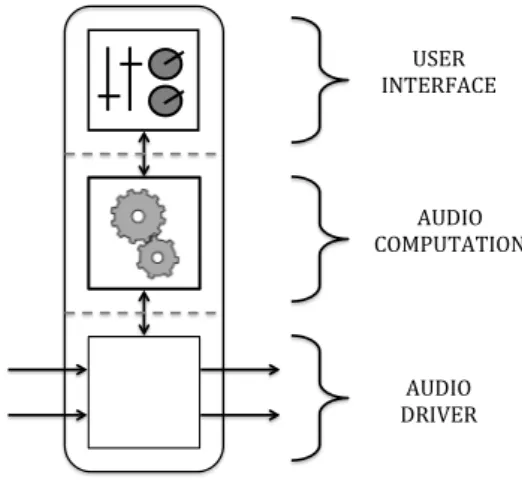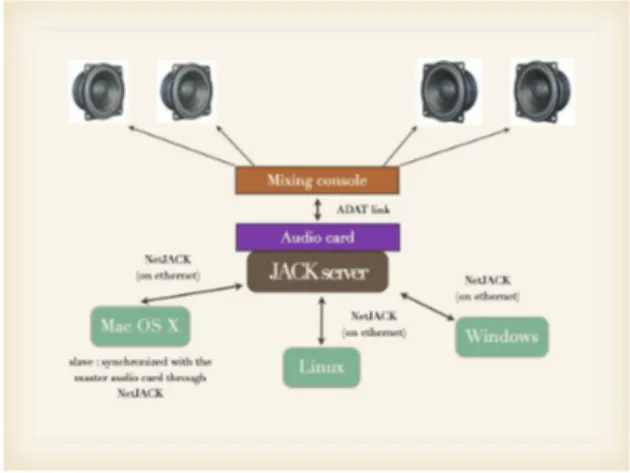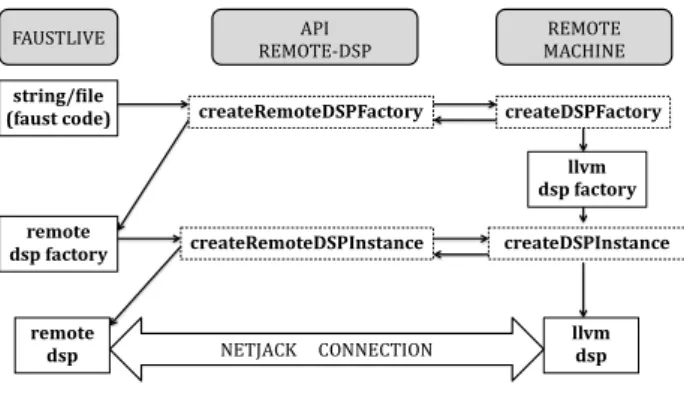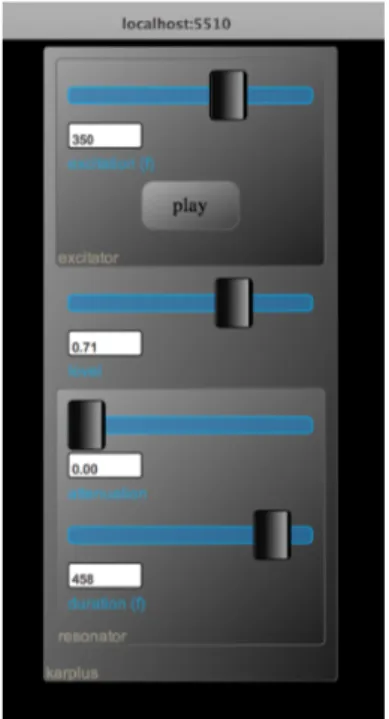HAL Id: hal-01349752
https://hal.archives-ouvertes.fr/hal-01349752
Submitted on 28 Jul 2016
HAL is a multi-disciplinary open access
archive for the deposit and dissemination of
sci-entific research documents, whether they are
pub-lished or not. The documents may come from
teaching and research institutions in France or
abroad, or from public or private research centers.
L’archive ouverte pluridisciplinaire HAL, est
destinée au dépôt et à la diffusion de documents
scientifiques de niveau recherche, publiés ou non,
émanant des établissements d’enseignement et de
recherche français ou étrangers, des laboratoires
publics ou privés.
Copyright
Audio Rendering/Processing and Control Ubiquity ? a
Solution Built Using the Faust Dynamic Compiler and
JACK/NetJack
Stephane Letz, Sarah Denoux, Yann Orlarey
To cite this version:
Stephane Letz, Sarah Denoux, Yann Orlarey. Audio Rendering/Processing and Control Ubiquity ? a
Solution Built Using the Faust Dynamic Compiler and JACK/NetJack. 40th International Computer
Music Conference joint with the 11th Sound & Music Computing conference (ICMC/SMC 2014), Jul
2014, Athènes, Greece. �hal-01349752�
Audio Rendering/Processing and Control Ubiquity ? a Solution Built Using the
Faust Dynamic Compiler and JACK/NetJack
Stephane Letz GRAME letz@grame.fr Sarah Denoux GRAME sdenoux@grame.fr Yann Orlarey GRAME orlarey@grame.fr ABSTRACT
We usually think of an audio application as a self-contained executable that will compute audio, allow user interface control, and render sound in a single process, on a unique machine.
With the appearance of fast network and sophisticated, light and wireless control devices (such as tablets, smart-phones...) the three different parts (that are audio computa-tion, interface control and sound rendering) can naturally be decoupled to run on different processes on a given ma-chine, or even on different machines (on a LAN or WAN network).
We describe a solution to run and control audio DSP on different machines based on:
• the FAUST audio DSP language which permits lo-cal and remote dynamic compilation, code migra-tion and deployment (using libfaust, libfaustremote and LLVM)
• local and remote control capabilities (via OSC and HTTPbased control interfaces)
• JACK/NetJack network audio real-time layer to han-dle remote audio processing and rendering.
1. INTRODUCTION
Audio applications are usually self-contained executables running on a single machine. Most of them can be ex-tended with additional audio processing capabilities using plug-ins following different standards (VST, Audio Unit, LV2, etc.). Control is usually either done directly by in-teracting with the application user interface, using the key-board, mouse, or multi-touch devices that liberate and ex-tend control access.
Several control protocols have been designed over the years, going from the old MIDI protocol to the more gen-eral and flexible Open Sound Control [1] one, and sevgen-eral more specialized ones (Mackie...).
Audio architectures themselves have evolved to offer to the developer and the user a more flexible infrastructure to
Copyright: c 2014 Stephane Letz et al. This is an open-access article distributed under the terms of theCreative Commons Attribution 3.0 Unported License, which permits unrestricted use, distribution, and reproduction in any medium, provided the original author and source are credited.
build custom working environments. The Jack Audio Con-nection Kit [2] (JACK) for instance not only allows appli-cations to share audio and MIDI devices, but also do inter-application audio and MIDI routing. With its NetJack ex-tension, networks of connected machines exchanging au-dio and MIDI streams in real-time on the LAN can be built. Alternative audio over network solutions, like Jack-Trip, an infrastructure over TCP/IP Wide Area Networks, have been developed and continuously extended [3], [4]. Concerning remote DSP processing, proprietary and com-mercial solutions like Apple Logic Pro distributed network audio system 1 have existed for years.
1.1 Control, Compute, Communicate
Until now, very few solutions have existed which easily compile, migrate and deploy arbitrary audio DSP code on different machines, only using open-source components. This can be done if the different parts of the audio appli-cation are clearly defined and separated, thus more clearly expressing the ubiquitous nature of the computation the ap-plication is going to achieve.
We can roughly describe any audio application as having three principal parts (see Figure 1), which are named with the Control-Compute-Communicate terminology:
• control: the control part changes the parameters in real-time
• compute: the audio DSP computation processes au-dio inputs and produces auau-dio outputs
• communicate (with the audio card): the audio ren-dering part triggers the audio computation.
This paper presents a practical solution using the FAUST
audio DSP language and the JACK/NetJack audio system where:
• control can be done locally or externally using the flexible architecture concept used to wrap FAUST
compiled code
• DSP code can be compiled and deployed locally or externally by “migrating” the DSP source itself, us-ing libfaust and libfaustremote libraries
• distributed audio rendering and processing can be implemented using the JACK/NetJack audio/MIDI infrastructure.
! ! "#$%! &'($%)*+$! *",&-! +-./"(*(&-'! *",&-! ,%&0$%! ! !
Figure 1. Audio application structure
2. FAUSTAUDIO DSP LANGUAGE
FAUST [Functional Audio Stream] [5] [6] [7] is a func-tional, synchronous, domain-specific programming language specifically designed for real-time signal processing and synthesis. A unique feature of FAUST, compared to other existing music languages like Max2, PureData, Supercol-lider, etc., is that programs are not interpreted, but fully compiled. FAUSTprovides a high-level alternative to C/C++
to implement efficient sample-level DSP algorithms.
2.1 The compilation chain
The FAUSTcompiler translates a FAUSTprogram into an equivalent imperative program (typically C, C++, Java, etc.), taking care of generating efficient code. The FAUST pack-age also includes various architecture files, providing the glue between the generated code and the external world (audio drivers and user interfaces).
! "#$%&! '()*+,-.! '()*+,-.!/00! 123!"456! 78'94:6':;86!"456! 6<6';:7=56! 73354'7:4>?!>8!35;/4?! '@@!"456!
Figure 2. Steps of FAUSTcompilation chain
The current version of the FAUSTcompiler produces the resulting DSP code as a C++ class, to be inserted in the architecture file. The C++ file is finally compiled with a regular C++ compiler to produce the final executable pro-gram or plug-in (Figure 2).
The resulting application is structured as shown in Figure 1. The DSP becomes an audio computation module, linked to the user interface and the audio driver.
If compilers have the advantage of efficiency, they have their own drawbacks compared to interpreters.
Compil-2the gen object added in Max6 now creates compiled code from a
patch-like representation, using the same LLVM based technology
ers traditionally require a whole chain of tools to be in-stalled (compiler, linker, development libraries, etc.). For non-programmers this task can be complex. The develop-ment cycle, from the edition of the source code to a run-ning application, is much longer with a compiler than with an interpreter. This can be a problem in creative situations where quick experimentation is essential. Moreover, bi-nary code is usually not compatible across platforms and operating systems.
2.2 FIR: Faust Imperative Representation
In order to generate alternative output (like pure C, Java, JavaScript, LLVM IR etc.), an intermediate language called FIR (Faust Imperative Representation) has been defined in the faust2 development branch. This language allows the description of the calculations performed on the samples in a generic manner. It contains primitives to read and write variables and arrays, perform arithmetic operations, and define the necessary control structures (for and while loops, if structure etc.). The language of signals internal to the compiler is now compiled in this FIR intermediate language.
2.3 LLVM
LLVM (formerly Low Level Virtual Machine) is a com-piler infrastructure, designed for compile-time, link-time, run-time optimization of programs written in arbitrary pro-gramming languages. Executable code is produced dy-namically using a “Just In Time” compiler from a spe-cific code representation, called LLVM IR 3. Clang, the
“LLVM native” C/C++/Objective-C compiler is a front-end for LLVM Compiler. It can, for instance, convert a C or C++ source file into LLVM IR code (Figure 3).
Figure 3. LLVM compiler structure
Domain-specific languages like FAUSTcan easily target the LLVM IR. This has been done by developing a special LLVM IR back-end in the FAUSTcompiler [8].
2.4 Dynamic compilation chain
The complete chain goes from the DSP source code, com-piled in LLVM IR using the LLVM back-end, to finally produce the executable code using the LLVM JIT. All steps are done in memory. Pointers on executable functions can be retrieved in the resulting LLVM module, and their code directly called with the appropriate parameters (Figure 4).
3The Intermediate Representationis an intermediate SSA
In the faust2 development branch, the FAUST compiler has been packaged as an embeddable library called lib-faust, published with an associated API [8]. This API imi-tates the concept of oriented-object languages, like C++.
The compilation step, usually executed by GCC, is ac-cessed through the function createDSPFactory. Given a FAUSTsource code (as a file or a string), the compilation chain (FAUST+ LLVM JIT) generates the “prototype” of the class, as a llvm-dsp-factory pointer.
Next, the createDSPInstance function, corresponding to the new className of C++, instantiates a llvm-dsp pointer, to be used as any regular FAUSTcompiled DSP object, run and controlled through its interface.
Figure 4. LLVM compiler structure
3. NETJACK NETWORK AUDIO LAYER NetJack is a real-time Audio Transport over a generic IP Network, fully integrated into JACK [2]. Based on a ter/slave model, NetJack synchronizes all clients to the mas-ter machine sound card, running all slaves with the same sampling rate and buffer size. When run directly in the JACK server, NetJack appears as two different parts (Fig-ure 5):
• the master component (netmanager in JACK2 4
im-plementation) is loaded in a server running and syn-chronized on an audio back-end
• the slave component is used as the back-end (net-jackback-end in JACK2 implementation) of a slave JACK server running on the remote machine. This way the slave machine is synchronized with the mas-ter machine so that no re-sampling on the slave side is needed.
This way, two (or more...) separated machines running each an entire JACK infrastructure (that is a JACK server and several JACK applications) are connected and synchro-nized through the network.
But the NetJack protocol is also available in a library called libjacknet that embeds and offers the master and slave components as a C API, to be used in applications developed outside of the JACK server context, as explained in the following sections.
3.1 Remote processing
Since the entire FAUSTDSP to executable code chain is now completely embeddable, it becomes quite easy and
4JACK2 is the C++ implementation of the JACK server and API
run-ning on major OS: Linux, OSX and Windows
Figure 5. Typical NetJack use case
natural to extend this model on the network to enable re-mote processing. This way, compilation and DSP compu-tation can easily be redirected on a remote machine.
3.1.1 Remote server
On the remote machine, the compilation/processing ser-vice appears as a specialized HTTP server waiting for re-quests. Remote processing service is detected on the local machine side using the libfaustremote library.
The first step (compilation) is carried out by the function createRemoteDSPFactory. The Faust DSP code is sent to the server, which compiles it and creates the “real” llvm-dsp-factory. The remote-dsp-factory returned to the user is a proxy for the “real” factory. Before sending the FAUST
code, a FAUSTto FAUSTcompilation step is locally exe-cuted, to solve all code dependencies, and thus send a com-pletely self-contained expanded code version to the server (Figure 6).
All available machines on the network can be scanned with getRemoteMachinesAvailable, and for a given one, already compiled DSP factories can be retrieved with ge-tRemoteFactoriesAvailable.
3.1.2 Local “proxy”
On the client side, a “proxy” API makes it transparent to create a remote-dsp pointer rather than a local llvm-dsp.
Using the createRemoteDSPInstance function, the remote-dsp-factory can then be instantiated to create remote-dsp instances, which can then run in the chosen audio/control architecture.
To be able to locally create the interface, the server re-turns a JSON encoded interface. This way, the function buildUserInterfacecan be recreated, giving the feeling that a remote-dsp works as a local llvm-dsp.
3.1.3 NetJack audio/control connection
Using a NetJack low-latency audio connection the audio data is sent (using the master component of the libjacknet library) to the remote machine to be processed and sent back (as a slave component of the libjacknet library).
In addition to the standard audio flow, one MIDI port is used to transfer the controller values (Figure 6). The
benefit of this solution is to transmit synchronized audio and controller values in the same connection. Audio sam-ples can be encoded using the different possible audio data types: float, integer, and compressed audio (using the OPUS
5 codec). ! ! ! ! ! ! ! ! ! ! ! ! ! ! ! ! ! ! ! ! ! ! !"# !"#$%""!"#$ !"#$%&'( !"#$%"! !"#$%#&#'(%#)*+,$!%("- !"#$%#&#'(%#)*+,-.%$-!# !"#$%#&'()$!%*"+ !"#$%#&'()*+%$*!# !"#$%&'() !!"#$!! !!"#!"#$%&' ! !!"#$!! !"# !!"#$%&!"#$! !!!"#$!!"#$! ! #$%&'()!!!!!(*##$(%+*#! !!"#!!"# !!"#! !"#!!"#$%&'
Figure 6. Remote compilation
The libfaustremote library uses libcurl to send HTTP re-quests to the remote server, handled with libmicrohttpd. The ZeroConf protocol is used to scan the remote machines presenting the service and export them as a list of available machines.
3.2 Remote rendering
NetJack layer can also be used to separate the audio pro-cessing and audio rendering parts. Instead of using it’s own sound card, the machine will start a NetJack slave audio driver, receiving its audio inputs from a remote NetJack master and sending back its audio outputs.
4. USER INTERFACE CONTROL
A FAUSTUI architecture is a glue between a host control layer and a FAUSTmodule. It is responsible for associat-ing a FAUSTmodule parameter to a user interface element and to update the parameter value according to the user’s actions.
This association is triggered by the buildUserInterface call, where the DSP object asks a UI object to build the module controllers. Moving UI elements later on changes parameter values which are “sampled” at each audio cycle and used by the DSP computation loop.
4.1 Local control
Local controllers are typically built using UI frameworks (like GTK or QT) that allow to create buttons, sliders, text entry zones or bargraphs. Those elements are then arranged on a complete window following an abstract layout de-scription that is part of the Faust DSP source.
4.2 Remote control
Moving controls on a remote machine assumes that a con-trol communication protocol has been defined between the local and remote machines.
5http://www.opus-codec.org
4.2.1 OSC control
The OSC [1] support opens the FAUSTapplications control to any OSC capable application or programming language. But it also transforms a full range of devices embedding sensors (wiimote, smartphones, tablets...) into physical in-terfaces for FAUSTapplications control, allowing their di-rect use as music instruments (Figure 8).
The UI with its layout and UI items hierarchy is encoded as a OSC address space, to be retrieved and used by OSC client applications. Several ports are defined:
• 5510 is the listening port number: control messages should be addressed to this port.
• 5511 is the output port number: answers to query messages are send to this port.
• 5512 is the error port number: used for asynchronous errors notifications.
4.2.2 HTTP control
The FAUSTHTTP architecture provides an UI architecture to be controlled by standard browsers. The compiled appli-cation embeds a specialized HTTP server (developed using the libmicrohttpd library), that waits for connections on a identified port (like 5510), delivers the UI to clients as a JSON encoded string with some JavaScript code to decode and display it, and build a fully controllable client side user interface.
To ease the opening of the interface, a Qr Code is built from the HTTP address, thanks to libqrencode. Most smart-phones and portable equipments have a QrCode decoder. By scanning the Qr Code, a browser gets connected to the interface page.
Control parameters are transferred in both directions, so that the browser can effectively display values produced by the DSP computation (like vumeters level for instance).
Several control machines can possibly be used, each one having its own opened browser. While the OSC control interface is designed to be used on a LAN network, the HTTP control model is easily usable on WAN, thus open-ing interestopen-ing possibilities (see Figure 7).
5. USE CASES
With the FAUST local and remote dynamic compiler and JACK/NetJack network audio layer in place, a wide variety of interesting use cases can now be put in practice.
5.1 Remote control
Any Faust DSP program can be remotely controlled using either the OSC or the HTTP architecture. The DSP object is dynamically wrapped by the appropriate user interface C++ class. This way it becomes accessible on the network for any available control application.
We have tested OSC control from Max/MSP patches, and HTTP control using standard browsers on laptop, tablets or even smartphones. Sound installations are a typical use case where publishing the Qr Code built from the HTTP address allows visitors to interact with the system.
Figure 7. HTTP interface: karplus DSP running in a browser with a SVG based UI built from the JSON ex-ported interface
Figure 8. OSC interface
5.2 Remote audio rendering
By using JACK/NetJack on a LAN, several slave machines can access a master one, which would typically be con-nected on a high quality studio audio system.
Another typical use case is a class room, where a unique sound system is available: all pupils can possibly connect their machines and use it (Figure 9).
5.3 Remote audio processing
Migrating DSP code on a remote machine (Figure 10) makes sense when CPU heavy DSP cannot be computed on the user’s machine. A typical case would be a composer com-ing with his/her laptop in the studio, and possibly uscom-ing the more powerful available machines.
Another interesting use case we have experimented to fa-cilitate the rapid development and experimentation of
au-Figure 9. NetJack based audio rendering
dio DSP programs on tablets and smartphones with the fol-lowing steps:
• a generic application running on the tablet/smartphone scans all machines on the network with getRemoteMa-chinesAvailable
• for a given one, already compiled DSP factories can be retrieved with getRemoteFactoriesAvailable
• a remote DSP instance then can be created, con-nected to the tablet/smartphone audio system, and locally controlled
We have successfully tested this example on a MacBook Pro laptop, with audio rendering and control running in wireless mode on an iPad 6. An audio effect can be
de-veloped and rapidly tested on the tablet, then later on fully compiled to native and self-contained version for final de-ployment.
Figure 10. Remote processing
5.4 FaustLive as a demonstration platform
Most of the scenarios described above can be tested out with FaustLive, a QT based application available on Linux, OSX and Windows. FaustLive is a standalone just-in-time FAUSTcompiler, that allows to easily write, test, experi-ment and deploy DSP programs [9].
6this is also an elegant way to deal with the current limitation of iOS,
which does not allow to embed a native dynamic compiler infrastructure on the tablet itself...
Distributed control, processing and rendering can also be tested on multiple machines using the application and JACK/NetJack infrastructure.
6. PERFORMANCES AND BENCHMARKS
The following section gives some numbers concerning the performance and capabilities of the “control, compute, com-municate” approach.
6.1 Compilation and startup
The first advantage of the fully dynamic and embedded compilation chain is to simplify the deployment of the Faust compiler technology itself. But it also gives major speedup in the compilation step when deploying FAUSTDSP code. Here are three examples of simple to quite heavy DSP pro-grams (Table 1).
Effect C++ time LLVM time karplus32 5.3s 0.3s cubic interpolation 6.5s 1.6s ethersonik 5.9s 0.7s
Table 1. Compilation and startup time for C++ and LLVM based chains, tested on a MacBook Pro 2,3 GHz
6.2 Remote processing and rendering
Running DSP code on the network using NetJack adds some latency. On a Gigabit LAN, roundtrip network la-tencies of 1 or 2 buffers can easily be obtained when using dozens of audio channels.
Wireless audio and control connections can be done, but more buffering packets have to be added in the NetJack connection. On a dedicated network we have tested an iPad to laptop connection, with 5 to 10 buffers of 1024 frames (compressed using the OPUS open-source codec) in the connection, thus adding an acceptable latency of 100 to 200 ms.
7. GETTING THE CODE
The various software components previously described are open-source projects available in the following sites.
• JACK server and NetJack can be found at:
http://jackaudio.org. Latest describe NetJack ver-sion is part of the soon to be published 1.9.10 verver-sion of the JACK infrastructure.
• FAUSTserver can be found at: http://faust.grame.fr
• libfaust and libfaustremote libraries are part of the faust2branch and can be found at:
http://sourceforge.net/projects/faudiostream/
8. CONCLUSION AND PERSPECTIVES As a result of FAUST dynamic code compilation and mi-gration capabilities based on libfaust, libfaustremote, and JACK/NetJack, audio DSP code can now be easily deployed and controlled on local and remote machines.
More precise benchmarks and analysis still need to be done on more complex audio DSP networks.
Moreover it could be interesting to have any FAUSTaudio DSP node embed its own DSP source (as a self-contained expanded string), so that a graph of connected audio DSP nodes could be analyzed and possibly be “rewritten” as an equivalent single FAUST DSP code, then possibly re-deployed on another target.
Acknowledgments
One part of this work is made possible by a grant from the French National Research Agency (ANR) INEDIT Project (ANR-12-CORD-0009), and for the other part by a grant from the French National Research Agency (ANR) FEEVER project (ANR-13-BS02-0008).
9. REFERENCES
[1] M. Wright and A. Freed, “Open Sound Control: A New Protocol for Communicating with Sound Synthesiz-ers”, International Computer Music Conference, 1997, pp. 101–104.
[2] S. Letz, N. Arnaudov and R. Moret, “What’s new in JACK2 ?”, Linux Audio Conference 2009.
[3] J.P. Caceres, C. Chafe, “JackTrip: Under The Hood of an Engine For Network Audio”, Journal of New Music Research, 39(3), 2010.
[4] J.P. Caceres, C. Chafe, “JackTrip/SoundWIRE meets server farm”, Computer Music Journal, 34(3), 2010.
[5] Y. Orlarey, D. Fober, and S. Letz, “Syntactical and se-mantical aspects of Faust”, Soft Computing, 8(9), 2004, pp. 623–632.
[6] Y. Orlarey, D. Fober, and S. Letz, “ Adding Auto-matic Parallelization to Faust”, Linux Audio Confer-ence, 2009.
[7] S. Letz., Y. Orlarey and D. Fober, “ Work Steal-ing Scheduler for Automatic Parallelization in Faust”, Linux Audio Conference, 2010.
[8] S. Letz, Y. Orlarey and D. Fober, “ Comment embar-quer le compilateur Faust dans vos applications ?”, Journees d’Informatique Musicale, 2013.
[9] S. Denoux, S. Letz, Y. Orlarey and D. Fober, “ FAUSTLIVE Just-In-Time Faust Compiler... and much more”, Linux Audio Conference, 2014.




